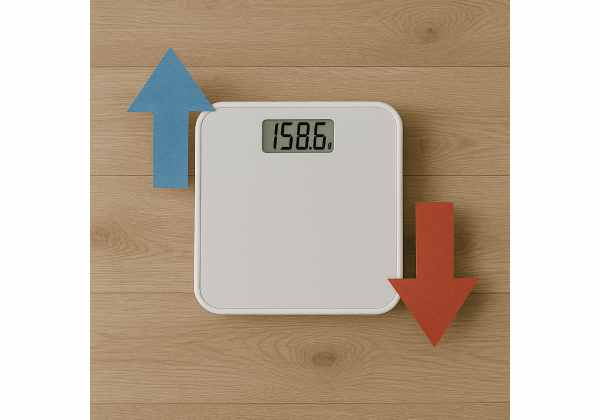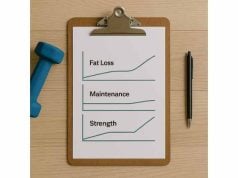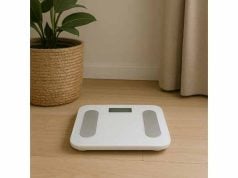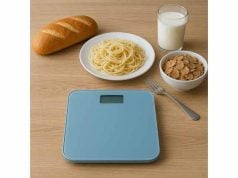
Daily weighing is not about chasing a smaller number every morning. It is a way to see the trend behind noisy day-to-day shifts from water, glycogen, sodium, late meals, and sleep. Done well, a quick, consistent check each morning produces clear weekly averages and less anxiety. You will learn how to weigh correctly, what swings are normal, and how to make decisions based on two- to four-week patterns rather than one surprising spike. If you are troubleshooting a stall or shifting into maintenance, pair this protocol with our structured plateau and maintenance troubleshooting so your decisions match the real data.
Table of Contents
- Daily weigh-in protocol explained
- How to weigh each day
- Water, glycogen and sodium swings
- Common mistakes and fixes
- Who should avoid daily weighing
- Interpreting trends and decisions
- Evidence, examples and templates
- Frequently Asked Questions
Daily weigh-in protocol explained
A single weigh-in cannot tell you whether you lost fat. Fat loss is a slow trend, while scale weight is a fast signal that bounces up and down with fluids, food in the gut, and glycogen. The purpose of a daily weigh-in protocol is to collect a consistent morning reading and convert seven numbers into one weekly average. That average, plus tape measurements and how your clothes fit, shows true progress.
Why daily over once-a-week?
- Weekly weigh-ins are vulnerable to bad timing (salty dinner, late workout).
- Seven data points smooth the noise. A Monday spike after travel has little impact on the average if the rest of the week is normal.
- Small but steady trends appear sooner, helping you adjust earlier and with less stress.
What “normal fluctuation” looks like
- Day-to-day changes of 0.3–1.0% of body weight are common for most people, especially after heavy training, high-carb meals, poor sleep, or menstrual shifts.
- Short spikes after a restaurant meal typically resolve in 24–72 hours.
- Creatine, new training blocks, and soreness can hold extra water temporarily without affecting fat loss.
What “actual fat loss” looks like
- The weekly average trends downward over two to four weeks.
- Waist or navel circumference drops; clothes fit easier; photos look tighter.
- Performance in the gym holds steady or improves with adequate protein.
What to pair with the scale
- A simple tape-measure panel (waist, navel, hips, thigh) once per week.
- Photos every one to two weeks under the same lighting and distance.
- A step average and protein average to track the inputs driving the outcome.
If you are new to energy balance and meal structure, skim our concise weight loss basics so your numbers and expectations line up with the protocol below.
How to weigh each day
Consistency beats perfection. Keep timing, setup, and routine the same so small changes mean something.
Your five-step morning routine (two minutes)
- Same time, right after the restroom, before food or drink.
- Minimal clothing (or the same outfit), dry skin, empty pockets.
- Place scale on a hard, level surface; avoid carpet or rubber mats.
- Stand still centered on the scale; let it settle; if your model gives two different readings, take a second and record the stable value.
- Log it immediately in your app or spreadsheet.
Weekly process
- Weigh daily; compute the weekly average every seven days (Sun–Sat or Mon–Sun).
- Compare average vs. average, not one day vs. one day.
- Review trends in two- to four-week windows before changing your plan.
Decision thresholds
- If the weekly average drifts down 0.3–0.7% of body weight per week (or roughly 0.25–0.75 kg for many), and waist is shrinking, stay the course.
- If the average is flat for two to four weeks and waist/hips do not change (with steady steps, protein, and sleep), make a small adjustment (see Section 6).
When the scale is unavailable
- Travel or shared spaces? Use same-day timing, similar clothing, and the same alternative scale if possible.
- If you miss days, resume without guilt. Your next weekly average will still be meaningful.
Complementary metrics
Even if you weigh daily, it is smart to track one non-scale metric. Progress pictures, a taped waist, and a “fit kit” from your closet provide context the scale cannot. If you need a quick setup, see our guide to non-scale tracking.
Mindset guardrails
- Your job is to collect, not to judge.
- Expect variability. The average is your report card; the dailies are just attendance.
Water, glycogen and sodium swings
Most “mystery” scale jumps are water. Understanding the usual suspects makes the noise less scary.
Glycogen refills
- Muscles store glycogen with water (roughly 3 grams of water per gram of glycogen).
- Higher-carb days after a low-carb stretch can raise scale weight 1–3 kg without adding fat.
- The reverse is true: a few low-carb days can drop weight quickly via water, not fat.
Sodium and late meals
- Salty restaurant food and late dinners temporarily increase water retention.
- Expect a 24–72 hour delay before the spike clears; do not change your plan over one noisy reading.
Training and soreness
- Hard sessions (especially new volume or eccentric lifts) cause temporary inflammation and water retention.
- Creatine increases intramuscular water, which can lift the scale a little while improving performance.
Sleep and stress
- Short nights, jet lag, and high stress elevate hormones that affect water and digestion, nudging weight up for a day or two.
Menstrual cycle
- Many see a luteal-phase rise before menstruation and a drop at or just after onset.
- Track cycle days in your log. Compare cycle-matched weeks (e.g., week 2 this month vs. week 2 last month) for a cleaner trend.
Alcohol
- Alcohol disrupts sleep and can swing fluids. Often you will see a short dip (dehydration) followed by a rebound as you rehydrate and eat saltier food.
The takeaway
You are not “off track” because you are up a kilogram after sushi night. Use your weekly average and waist measurement to interpret the story. For a deeper primer, skim our plain-English explainer on water and glycogen basics.
Common mistakes and fixes
Even a good protocol can fail if you change variables week to week. Keep these errors off your radar.
Mistake 1: Once-a-week weigh-ins
- A single off-schedule weigh-in is easy to misread.
- Fix: weigh daily and judge by weekly averages.
Mistake 2: Inconsistent timing or clothing
- Afternoon weigh-ins and post-workout checks are not comparable.
- Fix: same morning routine, minimal clothing, hard floor.
Mistake 3: New scale, new surface
- Switching devices or moving from tile to carpet changes readings.
- Fix: pick one scale and one location; if you must change, note the date and expect a small offset.
Mistake 4: Reacting to one spike
- Slashing calories after a salty dinner is a fast road to rebound.
- Fix: hold your plan for two to four weeks and adjust based on averages.
Mistake 5: Ignoring weekends
- Weekend overeating and low steps erase weekday deficits.
- Fix: set a two-day budget and a step floor; plan drinks and one indulgence per meal.
Mistake 6: Leaning only on the scale
- Body recomposition (muscle up, fat down) can hide on weight alone.
- Fix: add photos, tape, and clothes fit.
When you need a systematic tune-up beyond the scale, work through the pragmatic steps in our plateau checklist before cutting more calories.
Who should avoid daily weighing
Daily weighing is effective for many, but it is not for everyone. If the practice raises anxiety or fuels obsessive patterns, choose a different progress dashboard.
Consider alternatives if you:
- Have an active or past eating disorder, or current weight-focused compulsions.
- Are pregnant or within the early postpartum period (fluids and blood volume shift dramatically).
- Have conditions with significant fluid changes (certain heart, kidney, or liver issues) or take diuretics—follow clinical guidance.
- Find that daily numbers drive restriction/binge cycles or frequent plan changes.
Better options
- Weekly or cycle-matched measurements (waist/hips), progress photos, and a clothes “fit kit.”
- Performance markers: strength reps at a given RPE, walking pace, or session quality.
- Adherence markers: 7-day protein average, step average, sleep duration.
Cycle-related water
If premenstrual water swings make you dread the scale, emphasize cycle-matched comparisons and non-scale metrics. See our quick guide to cycle-related water retention to avoid mislabeling a phantom plateau as failure.
Bottom line
Choose the tracking style that keeps you steady and sane. The goal is clarity, not pressure.
Interpreting trends and decisions
You have daily numbers and weekly averages—now what? Use simple rules to protect adherence and make timely, minimal changes.
Set your targets
- Protein: 1.6–2.2 g/kg of goal body weight, with 25–40 g at breakfast and lunch.
- Steps: set a floor (e.g., 7–10k) and attach 10–12 minute walks to meals.
- Training: 3–5 lifting sessions/week, most sets at RPE 7–8.
Decision framework (every two weeks)
- Trend down + waist down: keep going.
- Weight flat + waist down: likely recomposition; hold steady.
- Weight flat + waist flat: confirm steps/protein/sleep; then change one lever:
- Movement first: add +1,000–2,000 steps/day or two 20–30 minute easy cardio sessions.
- Calories next: trim 100–200 kcal/day from carbs or fats (not protein).
- Maintenance pause: 1–2+ weeks at maintenance to restore training and mood, then resume a small deficit.
Weekend math
If your weekday average suggests a deficit but the weekly average is flat, audit Fri–Sun. Drinks, restaurant oils, and low steps often explain the gap. A two-day budget fixes more “stalls” than deeper cuts.
When to alter macros
If appetite is high or training is sluggish, a small macro re-balance (more protein/fiber, carbs nearer training, slightly lower fats) can restore control without reducing total calories. For specifics, see how to adjust calories and macros wisely.
Judge by averages, not anecdotes
Two to four weeks beat one dramatic day. Your averages and measurements tell the truth.
Evidence, examples and templates
You do not need a lab to run a smart protocol. Use these ranges and templates to make data collection simple and actionable.
Practical ranges
- Normal day-to-day drift: 0.3–1.0% of body weight (fluids, food, timing).
- Reasonable fat-loss pace: weekly average down 0.3–0.7% of body weight.
- Sodium/glycogen spikes: up to 1–3 kg for 24–72 hours after high-carb, salty meals.
- Cycle effects: predictable premenstrual rise with a drop near onset.
Sample four-week log (excerpt)
- Inputs: steps (7-day avg), protein (g/day), sleep (hours).
- Outputs: daily weigh-ins, weekly average, waist (cm), notes.
Week 1 (avg 78.4 kg): steps 8.4k, protein 135 g, sleep 7.2 h; waist 87.5 cm.
Week 2 (avg 78.1 kg): steps 9.1k, protein 140 g, sleep 7.5 h; waist 87.0 cm.
Week 3 (avg 78.2 kg): travel; two restaurant dinners; steps 7.2k; waist 87.0 cm.
Week 4 (avg 77.7 kg): steps 9.5k; protein 145 g; waist 86.3 cm.
How to read it
- Week 3 is a false stall: average barely up, waist flat, known reasons (sodium, sleep, steps).
- Week 4 trend resumes with stable inputs—no drastic change needed.
15-minute weekly routine
- Five minutes: tape measurements (waist/navel/hips).
- Five minutes: review daily weights; compute the weekly average.
- Three minutes: glance at photos or clothes “fit kit.”
- Two minutes: write a one-line decision: hold / add steps / adjust meals / cut 100–200 kcal.
Simple logging template (copy/paste into your notes)
- Date range:
- Weekly weight average:
- Waist (narrow/navel):
- Steps (7-day avg):
- Protein (g/day avg):
- Sleep (hours avg):
- Notes (sodium, travel, cycle day, training changes):
- Decision for next two weeks:
Why this system works
- It reduces noise to averages and trendlines.
- It links inputs to outputs so you adjust the smallest effective lever.
- It prevents panic cuts that hurt training, mood, and adherence.
Frequently Asked Questions
How often should I weigh myself for fat loss?
Daily is best if you can do it calmly. Use the same morning routine, then judge progress by weekly averages and two- to four-week trends. Pair the scale with waist measurements and clothes fit for a fuller picture, especially during fluid swings.
Why did my weight jump after a high-carb or salty meal?
Glycogen stores water and sodium affects fluid balance, so restaurant meals often raise weight 1–3 kg for 24–72 hours. That is water, not fat. Return to your routine, keep steps up, and watch the weekly average, not the next morning’s spike.
What if my weight is flat but my waist is shrinking?
You are likely losing fat while holding or gaining a little muscle—body recomposition. Keep protein high, training consistent, and steps steady. Judge progress by measurements, photos, and clothes fit alongside the weekly weight average.
How long should I wait before changing calories?
If your weekly weight average and waist/hip measurements are flat for two to four weeks, and steps/protein/sleep are consistent, adjust. Start with +1,000–2,000 steps/day or trim 100–200 kcal/day from carbs or fats, then reassess after two weeks.
I retain water around my period. Should I still weigh daily?
Yes, if it does not raise anxiety. Track cycle day and compare cycle-matched weeks (e.g., week 2 vs. week 2). Expect a rise in the luteal phase and a drop near onset. Use measurements and clothes fit to avoid misreading a phantom plateau.
Is daily weighing okay if the scale stresses me out?
If daily weighing worsens your mood or triggers restrictive patterns, switch to weekly or cycle-matched check-ins and rely on tape, photos, and a clothes “fit kit.” The best protocol is the one you can follow calmly and consistently.
References
- International society of sports nutrition position stand: nutritional concerns of the female athlete 2023 (Guideline)
- Muscle Glycogen Assessment and Relationship with Body Hydration Status: A Narrative Review 2022 (Systematic/Narrative Review)
- Frequency of Self-Weighing and Weight Change: Cohort Study With 10,000 Smart Scale Users 2021 (Cohort Study)
- Effect of the weight-loss program using daily self-weighing combined with personalized counseling led by village health volunteers in adults with obesity in a rural community, Thailand: a randomized controlled trial 2023 (RCT)
- Effects of Menstrual Cycle Phase on Fluid Regulation during Exercise 2020 (Review)
Medical Disclaimer
This article provides general education about daily weighing, fluid shifts, and fat loss. It is not a substitute for professional medical advice, diagnosis, or treatment. Always consult your licensed healthcare professional before changing your diet, exercise program, or medications—especially if you have medical conditions or are pregnant.
Share and Follow
If this protocol clarified the difference between weight noise and real fat loss, consider sharing it with someone who needs a calmer approach to the scale. You are also welcome to follow us on Facebook, X, or whichever network you use for practical updates and step-by-step guides.










